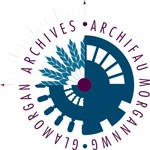The photograph selected from the Edwin Miles collection this week is something of an oddity. It is the only example that we have of Miles using several photographs in the production of a picture postcard. We also believe that it was produced in 1906 in collaboration with a very well-known and respected local artist, George Howell-Baker.

George Howell-Baker was an “artist, poet, illustrator and art teacher”, although he is probably best known as an artist. Examples of his work are held in the collections at the National Museum Wales, the Royal Collection, the Royal West of England Academy and the Glynn Vivian Art Gallery in Swansea. A number of his drawings were also published under the title “Penholm”.
In 1906 Howell-Baker lived on Coychurch Road, Bridgend. In addition to pursuing his own work, he delivered public lectures and ran art classes at a number of venues across South Wales. He was also a talented banjo player and often performed at local events. Two years earlier, in 1904, he had figured prominently in local and national newspapers when called to give evidence as a witness to a murder close to his home. He was, therefore, a well-known figure in the Bridgend area and would have been known to Edwin Miles, who was taking his first steps in building up a photography business based at Ewenny Road, Bridgend.
Is it reasonable to suggest that two men collaborated in the production of “Greetings from Pencoed”? In 1904 Howell-Baker had dabbled in the production of a set of postcards. However, rather than use photographs, the cards featured his own pen and ink drawings of local scenes, including Colwinstone Church and Llanmihangel House. There is no obvious evidence, therefore, that he produced cards using photographs. He did, though, add ornate sketches to his postcards that are similar to the approach used in framing the six photographs in “Greetings from Pencoed”.
As to Edwin Miles, he specialised in photographs of towns and villages in the Bridgend area. Many of his photographs focus on local landmarks such as large houses and churches, with very few onlookers. The six photographs in “Greetings from Pencoed” are very much in the style that Miles used across Glamorgan. Overall, for a greetings card, they are a very sober selection featuring the Pencoed railway station, two street scenes and three places of worship – Salem and Trinity Chapels and St David’s Church. There is no room in this collection for other popular Pencoed landmarks such as the Britannia Hotel and the Railway Inn.
Given that both Miles and Howell-Baker were interested in the production of postcards, it seems reasonable to assume that “Greetings from Pencoed” brought their talents together, with Howell-Baker providing the illustrations to frame the six photographs. If this is the case, then it seems that it was a partnership that did not flourish. There are no further examples in the Edwin Miles collection of work with Howell-Baker. If, however, anyone holds further information on the origins of “Greetings from Pencoed” then please get in contact. We would love to add to the story if there is more to be told.
We plan to feature more photographs from the Edwin Miles collection over the coming months. The main collection can be seen at Glamorgan Archives or online in the catalogue at http://calmview.cardiff.gov.uk/ under reference D261. “Greetings from Pencoed” can be seen under reference D261/M1045. Very little has been written about George Howell-Baker but there is a helpful Wikipedia page that draws together references to most of the known sources of information on the artist up to his death in 1919.
Tony Peters, Glamorgan Archives Volunteer
